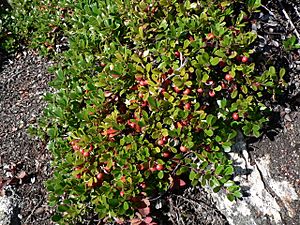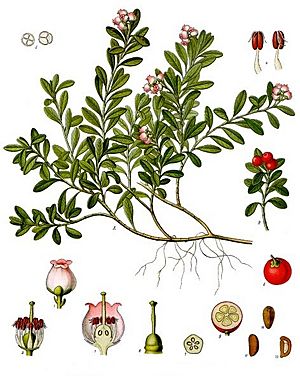Arctostaphylos uva-ursi facts for kids
Quick facts for kids Arctostaphylos uva-ursi |
|
|---|---|
 |
|
| Conservation status | |
| Scientific classification | |
| Genus: |
Arctostaphylos
|
| Species: |
uva-ursi
|
Arctostaphylos uva-ursi is a type of plant known as a bearberry. It grows in many cold northern parts of the world, like the subarctic areas of the Northern Hemisphere. In Canada and the United States, it is often called Kinnikinnick. This name comes from First Nations languages and means "smoking mixture."
The scientific name uva-ursi means "grape of the bear" in Latin. This is similar to the plant's main group name, Arctostaphylos, which means "bear grapes" in Greek.
Contents
What's in a Name?
The name Arctostaphylos uva-ursi has a cool meaning! The first part, Arctostaphylos, comes from Greek words. Arctos means "bear" and staphyle means "bunch of grapes". This is because bears in the wild love to eat the plant's fruits, which grow in clusters like grapes.
The second part of the name, uva-ursi, comes from Latin. Uva means "grape" and ursus means "bear". So, both parts of the name point to "bear grapes" or "bearberry"!
The common name, kinnikinnick, is an old Algonquin word. It means "smoking mixture". Long ago, Native Americans and early settlers would smoke the dried leaves and bark of this plant. They sometimes mixed it with other herbs or tobacco. People also call this plant by many other names, like mealberry or sandberry.
Where Bearberry Grows
Bearberry plants are found all around the northern parts of the world. They grow in cold places, but you can also find them in mountains further south.
- In Europe, they grow from Iceland all the way down to southern Spain and northern Greece.
- In Asia, they are found from arctic Siberia to Turkey and the Himalayas.
- In North America, they grow from arctic Alaska, Canada, and Greenland. You can find them south to California and in the Rocky Mountains and Appalachian Mountains. They are very common in British Columbia and Alberta.
Sometimes, this plant is rare or endangered in certain parts of the central United States.
What Bearberry Looks Like
Arctostaphylos uva-ursi is a small, woody plant that grows close to the ground. It usually stays between 5 and 30 centimeters (about 2 to 12 inches) tall. It's a groundcover shrub.
Its leaves are evergreen, meaning they stay green all year round for 1 to 3 years before falling off. The leaves are shiny, small, and feel thick. They are arranged one after another on the stems. The bottom of the leaves is a lighter green than the top.
New stems can be red if they get a lot of sun, but they are green in shadier spots. Older stems turn brown. In spring, the plant has pretty white or pink flowers. The fruit is a bright red berry.
The flowers are shaped like tiny urns and bloom from May to June. The fruits are round, fleshy, and bright red or pink. They are called drupes. These fruits stay on the plant until early winter. They can taste a bit bitter when raw, but they become sweeter if boiled and dried. Humans can eat the fruits, but most people don't find them very tasty. Each fruit has 1 to 5 hard seeds. Bears and other animals enjoy eating these berries.
Different Kinds of Bearberry
There are several different types of Arctostaphylos uva-ursi. For example:
- Arctostaphylos uva-ursi subsp. uva-ursi: This is the most common type. It grows all over the arctic and subarctic regions, and in mountains further south.
- Arctostaphylos uva-ursi subsp. cratericola: This type is special because it only grows in Guatemala at very high altitudes.
How People Use Bearberry
Food
Long ago, the Blackfeet Nation used bearberry fruits and leaves as food. The fruits don't have a strong taste when raw, but they can be used to make jelly. People also cooked the berries with meat to add flavor.
Dye
Native Americans used this plant to make a yellow dye.
Smoking
Dried bearberry leaves are a main part of many traditional Native American smoking mixtures. These mixtures are known as "kinnikinnick". They were used by many First Nations groups, sometimes mixed with other herbs or tobacco.
Traditional Medicine
For hundreds of years, First Nations people have used teas and extracts from bearberry leaves as traditional medicine. They used it to help with urinary tract infections, to help the body get rid of extra water, and to help with digestion. In herbalism, a tea made from the leaves is used to help with inflammation in the urinary system.
Growing Bearberry in Gardens
Many people grow bearberry plants as ornamental plants in their gardens. It's a beautiful evergreen groundcover that looks good all year. It's also helpful for stopping erosion on hillsides because its roots grow deep. Bearberry can handle a lot of sun and dry soil. This makes it a popular plant for gardens in cities, natural areas, and rock gardens.
|
See also
 In Spanish: Gayuba para niños
In Spanish: Gayuba para niños






